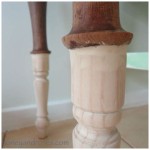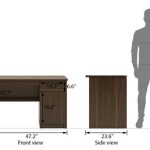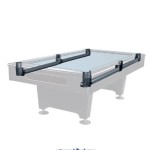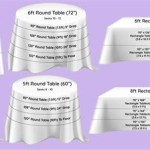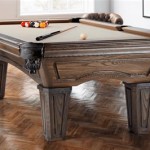How To Build A Folding Table
The construction of a folding table represents a practical woodworking project, offering a space-saving solution for various needs, from supplemental dining space to temporary work surfaces. This article outlines a comprehensive guide to building a sturdy and reliable folding table, encompassing material selection, component fabrication, assembly procedures, and finishing techniques. Emphasis is placed on clear instructions and precise measurements to facilitate a successful outcome for woodworkers of intermediate skill levels.
Prior to commencement, it is crucial to establish a well-defined plan, specifying the desired dimensions of the table, the type of wood to be used, and the specific hardware required. This preliminary planning stage not only streamlines the building process but also minimizes potential errors and ensures a structurally sound and aesthetically pleasing final product.
Choosing Materials and Tools
The selection of appropriate materials is paramount to the longevity and functionality of the folding table. Hardwoods, such as maple, oak, or birch, are preferred for the tabletop and supporting frame due to their inherent strength and resistance to wear. Softwoods, such as pine or fir, can be used for less critical components, but they may require reinforcement to withstand repeated use and folding.
The choice of wood grade will also impact the final appearance and cost of the table. Select-grade lumber is virtually free of knots and imperfections, resulting in a more uniform and visually appealing surface. Common-grade lumber, however, is more economical and can be used effectively if knots are strategically positioned or filled with epoxy resin.
Beyond lumber, the necessary hardware includes hinges, locking mechanisms, screws, wood glue, and finishing materials. Hinges of robust construction, such as piano hinges or heavy-duty butt hinges, are essential to ensure smooth and reliable folding action. Locking mechanisms, such as folding table leg brackets or simple latches, prevent the table from collapsing during use. Screws should be of appropriate length and gauge to provide secure fastening without splitting the wood. Wood glue, specifically formulated for woodworking applications, enhances the strength of joints. Finishing materials, such as stain, sealant, and polyurethane, protect the wood from moisture and abrasion, extending its lifespan.
A standard woodworking toolkit is required for this project, including a table saw or circular saw, a miter saw, a drill, a sander, clamps, measuring tools (tape measure, square, marking gauge), and safety equipment (eye protection, hearing protection). Access to a router and router table can be beneficial for creating decorative edges or joinery details.
Building the Tabletop and Frame
The tabletop typically consists of several boards joined together to achieve the desired width. The boards should be carefully selected to minimize warping and cupping. Prior to joining, the edges of each board should be planed or jointed to ensure a perfectly flat and square surface for gluing.
The boards can be joined using various techniques, including edge gluing, tongue-and-groove joints, or biscuit joints. Edge gluing involves applying wood glue to the edges of the boards and clamping them together until the glue dries. Tongue-and-groove joints provide a stronger and more stable connection, while biscuit joints offer a simpler alternative with good alignment. Regardless of the chosen technique, it is crucial to apply even pressure during clamping to ensure a seamless joint.
Once the tabletop is assembled, it should be sanded smooth, starting with a coarse grit sandpaper and progressing to finer grits. The edges of the tabletop can be rounded over using a router or sanding block to prevent sharp edges.
The frame provides structural support for the tabletop and houses the folding mechanism. It typically consists of four aprons, which are attached to the underside of the tabletop using screws and wood glue. The aprons should be made from the same type of wood as the tabletop and should be dimensioned to provide adequate support. The corners of the frame can be joined using mortise-and-tenon joints, dowel joints, or simple butt joints reinforced with corner braces. Mortise-and-tenon joints offer the strongest connection, while dowel joints provide a more streamlined appearance. Butt joints are the simplest to construct but require additional reinforcement to ensure structural integrity.
The dimensions of the frame should be precisely measured to ensure that the folding legs fit properly and that the table is stable when unfolded. The frame should be securely attached to the underside of the tabletop, ensuring that it is flush with the edges.
Installing the Folding Mechanism and Legs
The folding mechanism is the heart of the folding table, enabling it to be easily stored when not in use. Various types of folding mechanisms are available, including folding table leg brackets, piano hinges, and drop-leaf hinges. The choice of mechanism depends on the desired aesthetics, folding method, and level of support required.
Folding table leg brackets are typically used for tables with legs that fold inward. These brackets are attached to the frame and the legs, allowing the legs to pivot inward when folded. Piano hinges are long, continuous hinges that provide a smooth and strong folding action. They are often used for drop-leaf tables, where a portion of the tabletop folds down. Drop-leaf hinges are specifically designed for drop-leaf tables, allowing the leaf to be easily raised and lowered.
The legs should be made from the same type of wood as the tabletop and frame and should be dimensioned to provide adequate support. The legs should be securely attached to the folding mechanism, ensuring that they are aligned properly and that they fold smoothly. The length of the legs determines the height of the table when unfolded. Consider the intended use of the table when determining the leg length. For example, a dining table should be approximately 30 inches high, while a coffee table should be approximately 18 inches high.
Once the legs are attached, the folding mechanism should be tested to ensure that it functions properly. The legs should fold smoothly and lock securely in both the folded and unfolded positions. Any adjustments or modifications should be made at this stage to ensure optimal performance.
Consider adding cross braces between the legs for enhanced stability. These braces can be made from the same type of wood as the legs and should be attached using screws and wood glue. The cross braces will prevent the legs from wobbling and will distribute weight more evenly across the table.
Finishing and Hardware Installation
Once the table is fully assembled, the finishing process enhances its appearance and protects it from damage. Sand the entire table with fine-grit sandpaper to remove any remaining imperfections and create a smooth surface for finishing.
Staining the wood allows for customization of the table's color and appearance. Apply the stain evenly, following the manufacturer's instructions. Allow the stain to dry completely before applying a sealant, such as varnish or lacquer. A sealant protects the wood from moisture and abrasion. Apply several coats of sealant, sanding lightly between each coat to create a smooth and durable finish.
Polyurethane provides a durable and water-resistant finish, making it ideal for tables that will be used frequently or exposed to moisture. Apply several coats of polyurethane, allowing each coat to dry completely before applying the next. Sand lightly between each coat to create a smooth and even finish.
Install any remaining hardware, such as locking mechanisms or corner braces, after the finishing process is complete. Ensure that all screws are tightened securely and that all hardware functions properly.
Thoroughly inspect the finished table for any defects or imperfections. Sand and refinish any areas as needed to achieve a professional-looking result. The finished folding table should be sturdy, functional, and aesthetically pleasing, providing a valuable addition to any home or workspace.

How To Make A Folding Table 20 Diy Plans Wood Outdoor

Free Woodworking Plans To Build A Fabulous Folding Table The Design Confidential

Free Woodworking Plans To Build A Fabulous Folding Table The Design Confidential

How To Build A Folding Table Simple Diy Woodworking Project

How To Make An Outdoor Folding Table Tutorial Pneumatic Addict

Folding Table 10 Steps With S Instructables

How To Build A Folding Table Simple Diy Woodworking Project

How To Build An Easy Diy Folding Table Family Handyman

How To Build A Collapsible Portable Table

How To Build A Folding Workbench Addicted 2 Diy
Related Posts

